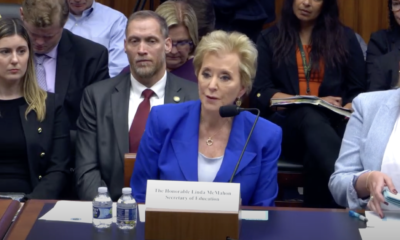2024 election
Harris’ Nomination Sparks Renewed Energy Among Latina Supporters of Democrats

As the presidential election approaches, President Joe Biden’s support among Latinx voters appears to have waned since 2020. Concerns have risen particularly among Latinas, a demographic historically aligned with Democratic candidates. Stephanie Valencia, from Equis Research, a firm that analyzes voting trends among Latinx communities, noted a troubling drop in support as the summer unfolded.
A significant shift occurred when Biden announced Vice President Kamala Harris as his replacement on the Democratic ticket. With fewer than 100 days until election day, Valencia and her team initiated research to assess Harris’s reception among Latinx voters in key battleground states.
After surveying over 2,000 Latinx voters in late July and early August, Equis discovered a notable resurgence in support for the Democratic ticket, which they termed the “Latino Reset.” This was particularly evident among younger Latinas, especially those under 40 years old, signaling a marked shift in sentiment.
Valencia expressed concern regarding the initial gender gap observed early in the election cycle but highlighted how Harris’s candidacy re-energized enthusiasm among Latinx voters. “We began to notice a concerning trend of women moving away from Biden’s support,” she stated. “However, with Kamala, we’ve observed a substantial turnaround.”
Specifically, Harris achieved a support rate of 59 percent among Latinas, a significant leap compared to Biden’s earlier support. In comparison, Latino men showed increased support as well, moving from 41 percent under Biden to 51 percent under Harris.
When asked about the increasing support from Latinas under 40, Valencia identified several factors. “The recent events in the Middle East shaped opinions around that age group,” she noted. “Additionally, Harris’s vibrant public presence, alongside her personal immigrant narrative, has established a connection with many younger voters.”
Harris’s ad campaign, which incorporates her background as a child of immigrants, deviates from conventional narratives targeting Latinx communities. “This approach resonates as it acknowledges the immigrant experience authentically,” Valencia remarked. “It’s a relevant message many can identify with.”
Turning to critical battlegrounds like Arizona and Nevada, Valencia reported noteworthy findings. In Arizona, Harris has received a support rating of 61 percent among Latinos, aiming to match Biden’s 2020 performance of 63 percent. In Nevada, she currently holds 55 percent support, needing to elevate it to at least 59 percent to maintain competitive viability.
The demographic expansion of Latinx communities extends beyond these states, with promising growth observed in locations like Wisconsin, North Carolina, and Pennsylvania. Valencia emphasized, “In certain areas, Latino populations have surged, and this demographic can significantly influence election outcomes.”
Looking ahead, the Harris campaign will need to maintain momentum and convert survey support into actual voter turnout. “Democrats must engage with Latino voters genuinely and address their specific concerns,” Valencia advised. The campaign’s introduction of a WhatsApp broadcast channel illustrates a strategic move to connect with younger voters effectively.
“Latinos utilize WhatsApp extensively, making it a potent tool for communication,” she noted. The landscape of voter outreach continues to evolve, and understanding the preferences of diverse communities will be critical to the success of any campaign.


















